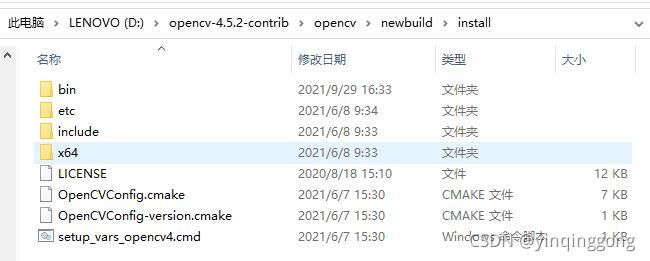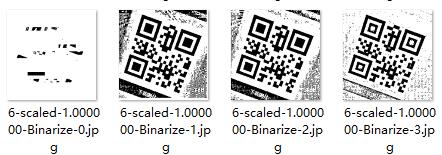微信二维码识别研究
微信二维码识别研究
文章目录
- 微信二维码识别研究
- 前言
- 一、在Win10下编译OpenCV4.5.2(含opencv_contrib)
- 二、调试步骤
-
- 1.链接OpenCV
- 2.编写Demo
- 3.为Demo配置环境(Debug环境)
- 4.修改OpenCV源码
- 三、微信二维码解码流程,浅见
-
- 1.二维码定位
- 2.二维码解码
前言
由于工作原因,需要熟悉二维码解析流程,正好微信在Opencv4.5.2中开源了wechat_qrcode源码,现对第一阶段调研做下记录。
提示:以下是本篇文章正文内容,下面案例可供参考
一、在Win10下编译OpenCV4.5.2(含opencv_contrib)
本人使用的是vs2019编译,感谢如下博文:
win10 下编译用于 Visual Studio 2019 的 OpenCV4.5.2(含 opencv_contrib 扩展模块)附编译好的OpenCV(图文)
二、调试步骤
1.链接OpenCV
编译opencv生成解决方案后,右键CMakeTargets下的INSTALL->仅用于项目->仅生成INSTALL,顺利的话,install目录如下:

2.编写Demo
另起VS的Demo工程,代码如下(本人根据自己需要修改了opencv源码,接口增加了参数用于对比测试):
#include 3.为Demo配置环境(Debug环境)
Visual Studio配置第三方库的常规操作,如下:
(1)项目右键属性->VC++目录->包含目录:
D:\opencv-4.5.2-contrib\opencv\newbuild\install\include
D:\opencv-4.5.2-contrib\opencv\newbuild\install\include\opencv2
(2)项目右键属性->VC++目录->库目录:
D:\opencv-4.5.2-contrib\opencv\newbuild\install\x64\vc16\lib
(3)项目右键属性->链接器->输入:
opencv_world452d.lib
(4)将步骤1目录中生成的opencv_world452d.dll(\install\x64\vc16\bin)放置到demo.exe同级
(5)在opencv工程的INSTALL项目右键属性->调试->命令,输入demo.exe位置:
D:\aaWorkspace\WeChatQRCodeDemo\QRCodeDemo\x64\Debug\demo.exe
然后就可以断点调试opencv中相关源码了
4.修改OpenCV源码
(1)修改之后保存文件,对opencv工程右键->生成解决方案,注意不要点击重新生成解决方案
(2)CMakeTargets下的INSTALL右键->仅用于项目->仅生成INSTALL,重新生成opencv_world452d.dll,替换demo.exe同级目录下文件
三、微信二维码解码流程,浅见
1.二维码定位
try {
detector = makePtr<wechat_qrcode::WeChatQRCode>(
"D:\\opencv-4.5.2-contrib\\opencv\\newbuild\\downloads\\wechat_qrcode\\detect.prototxt",
"D:\\opencv-4.5.2-contrib\\opencv\\newbuild\\downloads\\wechat_qrcode\\detect.caffemodel",
"D:\\opencv-4.5.2-contrib\\opencv\\newbuild\\downloads\\wechat_qrcode\\sr.prototxt",
"D:\\opencv-4.5.2-contrib\\opencv\\newbuild\\downloads\\wechat_qrcode\\sr.caffemodel");
}
int WeChatQRCode::Impl::applyDetector(const Mat& img, vector<Mat>& points) {
int img_w = img.cols;
int img_h = img.rows;
// hard code input size
int minInputSize = 400;
float resizeRatio = sqrt(img_w * img_h * 1.0 / (minInputSize * minInputSize));
int detect_width = img_w / resizeRatio;
int detect_height = img_h / resizeRatio;
points = detector_->forward(img, detect_width, detect_height);
return 0;
}
微信使用训练好的深度学习的SSD目标检测模型推理出二维码矩形候选区域,又快又准,模型也很小
2.二维码解码
(1)解码前对候选区域做padding,宽高扩大10%
Mat WeChatQRCode::Impl::cropObj(const Mat& img, const Mat& point, Align& aligner) {
// make some padding to boost the qrcode details recall.
float padding_w = 0.1f, padding_h = 0.1f;
auto min_padding = 15;
auto cropped = aligner.crop(img, point, padding_w, padding_h, min_padding);
return cropped;
}
(2)缩放尺寸,多次尝试
// empirical rules
vector<float> WeChatQRCode::Impl::getScaleList(const int width, const int height) {
if (width < 320 || height < 320) return {1.0, 2.0, 0.5};
if (width < 640 && height < 640) return {1.0, 0.5};
return {0.5, 1.0};
//yqg
//return { 1.0, 2.0, 0.5 };
}
(3)在ZXing的基础上扩展,采用4种二值化方式轮流尝试解码
enum BINARIZER {
Hybrid = 0,
FastWindow = 1,
SimpleAdaptive = 2,
AdaptiveThreshold = 3
};
// Four Binarizers
int tryBinarizeTime = 4;
for (int tb = 0; tb < tryBinarizeTime; tb++) {
if (source == NULL || height * width > source->getMaxSize()) {
source = ImgSource::create(scaled_img_zx.data(), width, height);
} else {
source->reset(scaled_img_zx.data(), width, height);
}
int ret = TryDecode(source, zx_result, scaled);
if (!ret) {
result = zx_result->getText()->getText();
return ret;
}
else//yqg
{
string scaledPath = "D:\\aaWorkspace\\WeChatQRCodeDemo\\QRCodeDemo\\steps\\img" + to_string(index) + "\\5-" + to_string(qr) + "-scaled-" + to_string(scaled) + "-try-Binarize-" + to_string(tb) + "-failed.jpg";
imwrite(scaledPath, src);
}
// try different binarizers
binarizer_mgr_.SwitchBinarizer();
}
}
(4)得到合适的二值化图片后开始解码,寻找三个定位点,透视变换等,又要忙别的了,抽空再看吧。。。

